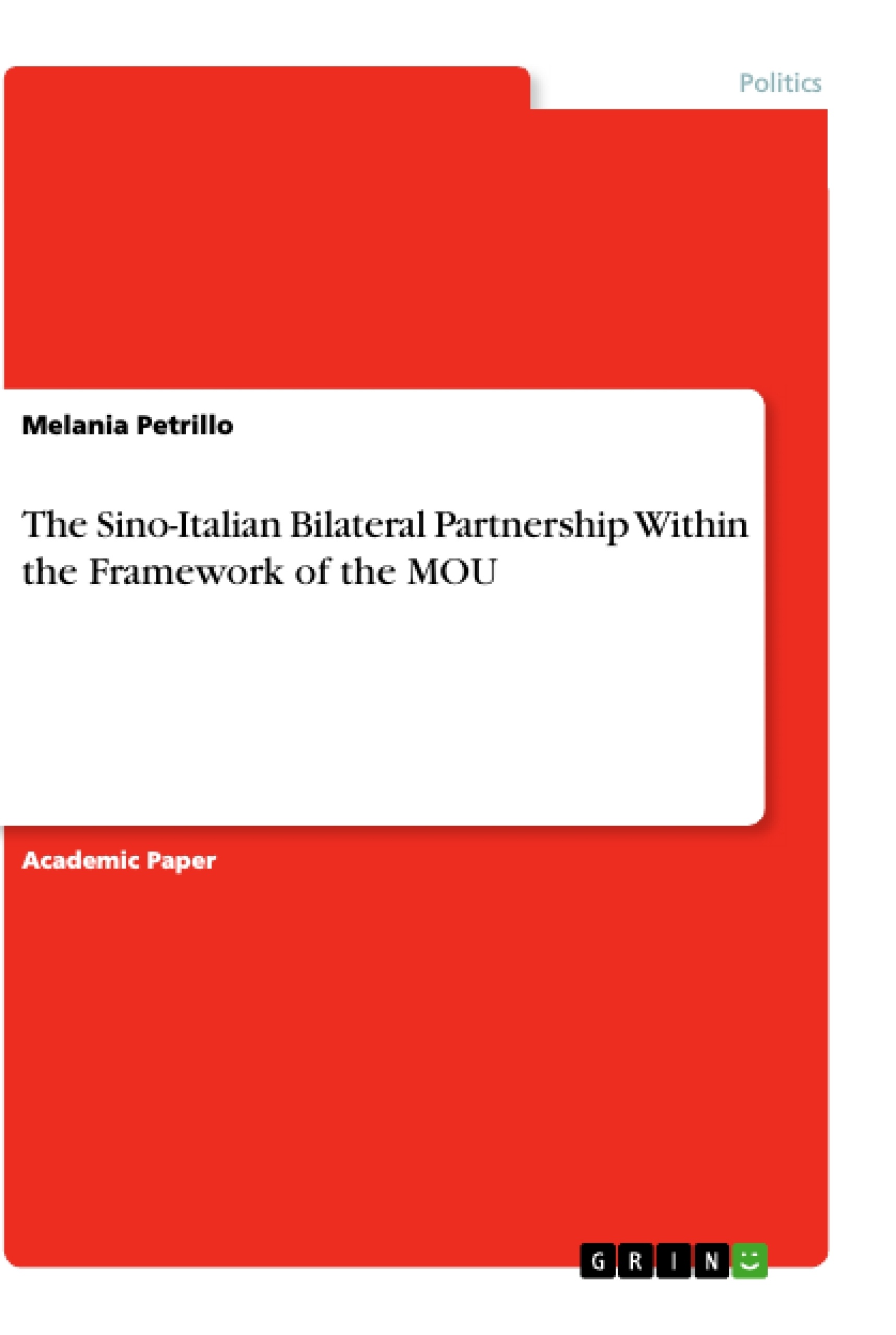This research aims to analyze the ongoing progress of the China-Italy bilateral partnership, exploring the benefits and advantages for both countries, considering the economic recess of Italy (such as lack of investments in the infrastructures, in the research and innovation field), but its strategic geographical position and the ‘Made in Italy’. It also ponders the importance of Chinese direct investments in Italy, imports-exports, and the advantages of joining the Belt and Road Initiative.
China and Italy have signed nineteen deals stated in the MOU, which set off a new era for the Sino-Italian bilateral partnership (ten more are between private companies). Italy also joined the ‘Belt and Road Initiative’, the People’s Republic of China’s infrastructure maxi plan, which includes ports, railway lines, roads, and maritime corridors. The nineteen institutional arrangements, in addition to the collaboration within the ‘Economic Silk Road’ and the 21st Century Maritime Silk Road Initiative, range from promoting collaboration between innovative start-ups to the agreement between the two governments to eliminate double taxation on income taxes as well as to prevent tax evasion and avoidance through a protocol on plant protection requirements for the export of fresh citrus from Italy to China and a MOU on the prevention of theft, clandestine excavations, import, export, trafficking and illicit transit of cultural goods together with the promotion of their return.
Inhaltsverzeichnis (Table of Contents)
- 摘要 (Abstract)
- 引言 (Introduction)
- 第一章: 中国与意大利双边伙伴关系的回顾 (Chapter 1: A Look Back at the China-Italy Bilateral Partnership)
- 1.1 中意关系的历史 (1.1 History of China-Italy Relations)
- 1.2 中意双边关系的现状 (1.2 Current Status of China-Italy Bilateral Relations)
- 第二章: “一带一路”倡议与中意合作 (Chapter 2: The Belt and Road Initiative and Cooperation Between China and Italy)
- 2.1 “一带一路”倡议的背景 (2.1 Background of the Belt and Road Initiative)
- 2.2 “一带一路”倡议与意大利的战略意义 (2.2 Strategic Significance of the Belt and Road Initiative for Italy)
- 第三章: 中意经贸合作现状与展望 (Chapter 3: The Current Status and Prospects of Economic and Trade Cooperation Between China and Italy)
- 3.1 中意贸易合作现状 (3.1 Current Status of China-Italy Trade Cooperation)
- 3.2 中意投资合作现状 (3.2 Current Status of China-Italy Investment Cooperation)
- 3.3 中意经贸合作展望 (3.3 Prospects of China-Italy Economic and Trade Cooperation)
- 第四章: 中意双边伙伴关系面临的机遇与挑战 (Chapter 4: Opportunities and Challenges Facing the China-Italy Bilateral Partnership)
- 4.1 机遇 (4.1 Opportunities)
- 4.2 挑战 (4.2 Challenges)
- 第五章: 结论 (Chapter 5: Conclusion)
Zielsetzung und Themenschwerpunkte (Objectives and Key Themes)
This study aims to analyze the progress made in the China-Italy bilateral partnership, examine the shared interests and advantages of the two countries, and provide insights into Italy's economic recession (lack of infrastructure investment, insufficient investment in research and innovation, etc.), Italy's advantageous strategic geographical location, and the high-quality “Made in Italy” brand. Meanwhile, this study evaluates the importance of China's investment in Italy, the significance of import-export trade, and the benefits of Italy joining the Belt and Road Initiative.
- The historical and contemporary state of the China-Italy bilateral relationship
- The impact of the Belt and Road Initiative on China-Italy cooperation
- The current status and future prospects of economic and trade cooperation between China and Italy
- The opportunities and challenges facing the China-Italy bilateral partnership
- The strategic benefits and economic implications of Italy's participation in the Belt and Road Initiative
Zusammenfassung der Kapitel (Chapter Summaries)
Chapter 1: A Look Back at the China-Italy Bilateral Partnership delves into the historical development of relations between China and Italy, tracing the roots of their interaction back to ancient times. The chapter examines the evolving nature of their bilateral ties, highlighting significant milestones and key areas of cooperation throughout the years. It then analyzes the present status of their relationship, emphasizing the deepening economic and political interdependence between the two nations.
Chapter 2: The Belt and Road Initiative and Cooperation Between China and Italy explores the significance of the Belt and Road Initiative for China and its implications for Italy. It provides an overview of the initiative, outlining its objectives and scope. The chapter delves into the strategic benefits of the initiative for Italy, considering factors such as infrastructure development, economic growth, and connectivity. It also examines the potential challenges associated with the initiative for Italy, including concerns related to debt, geopolitical dynamics, and cultural differences.
Chapter 3: The Current Status and Prospects of Economic and Trade Cooperation Between China and Italy focuses on the state of economic and trade relations between the two countries. It analyzes the dynamics of trade cooperation, examining the major export and import sectors, trade flows, and investment trends. The chapter also explores the current status of investment cooperation, highlighting key sectors of interest, investment projects, and the role of Chinese businesses in Italy's economic landscape. Finally, it delves into the future prospects of economic and trade cooperation, analyzing potential areas of growth and exploring opportunities for further collaboration between China and Italy.
Chapter 4: Opportunities and Challenges Facing the China-Italy Bilateral Partnership analyzes the opportunities and challenges facing the China-Italy bilateral partnership. It highlights the potential benefits for both countries, exploring the potential for increased trade, investment, and cultural exchange. However, it also acknowledges the challenges posed by geopolitical dynamics, economic disparities, and cultural differences. The chapter delves into potential strategies for overcoming these challenges and fostering a more sustainable and mutually beneficial partnership between the two nations.
Schlüsselwörter (Keywords)
This study revolves around the core themes of the China-Italy bilateral partnership, economic and trade cooperation, mutual interdependence, and the opportunities and challenges associated with this relationship. It investigates the strategic implications of Italy's participation in the Belt and Road Initiative, analyzing the economic benefits, geopolitical considerations, and potential risks involved. The study highlights key concepts like infrastructure development, investment flows, trade dynamics, and the significance of cultural exchange in fostering a mutually beneficial partnership. Furthermore, it explores the role of “Made in Italy” brand in the context of the China-Italy partnership, examining its potential for economic growth and international recognition.
- Quote paper
- Melania Petrillo (Author), 2022, The Sino-Italian Bilateral Partnership Within the Framework of the MOU, Munich, GRIN Verlag, https://www.grin.com/document/1169030



